Manchester, Michigan
Manchester is famous among the Lithuanian-Americans for having two of the top Lithuanian camps in the USA: "Dainava" and "Pilėnai". Lithuanian-American camps are not simply places to spend summer holidays; rather, they are an attempt to recreate a piece of Lithuania abroad. Therefore, they have a fair share of Lithuanian monuments and artworks.
During the camping season (mostly summer), they attract hundreds of Lithuanians who seek to spend some time in a Lithuanian atmosphere and among other Lithuanians. Outside of the season and the main events, they are calm and feel more like Lithuanian parks/memorials.
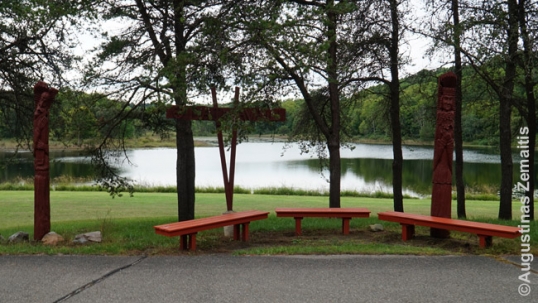
The Dainava camp monument man sign with its lake on the background amidst Lithuania-like scenery
Dainava Lithuanian camp
Dainava camp is the largest Lithuanian camp in America. It is also interesting as a tourist attraction as it has a lot of atmospheric sites and is effectively a large Lithuanian-themed park, 225 acres (91 ha) in size.
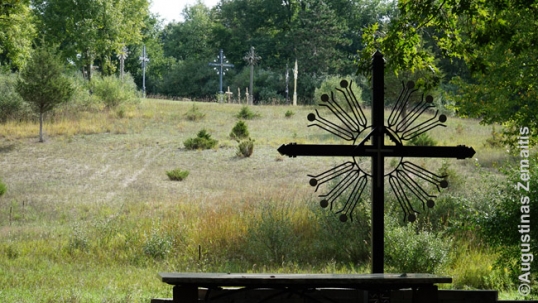
Camp Dainava
A symbolic heart of Dainava is its Hill of Crosses, a smaller copy of the famous Hill of Crosses near Šiauliai. It has been started in 1975 but, just like its bigger brother in Lithuania, it constantly grows as new crosses are added. Currently, there are 8 large crosses and many small crosses, with the smallest one being hung on the larger ones just like in Šiauliai. Lithuanian cross-crafting is a UNESCO immaterial world heritage and Dainava crosses follow this artform rigorously. Recently, more permanent metal crosses have also been built (e.g. 2011 one by Marius Narbutaitis and 2008 by Ateitininkai). Three of the large wooden crosses are dedicated to Jonas Masiliūnas, a Soviet-murdered Lithuanian interwar politician (1899-1942), Aidas Kriaučiūnas, and Bradūnas family. Like everywhere in Dainava, many crosses also have patriotic symbols in addition to the religious ones.
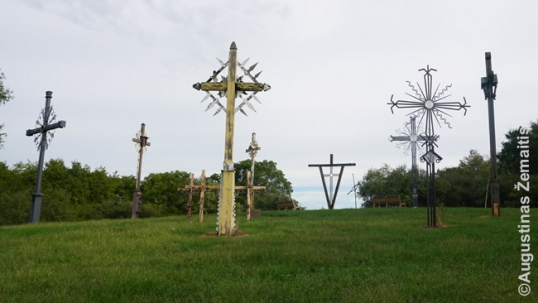
Hill of Crosses of Dainava
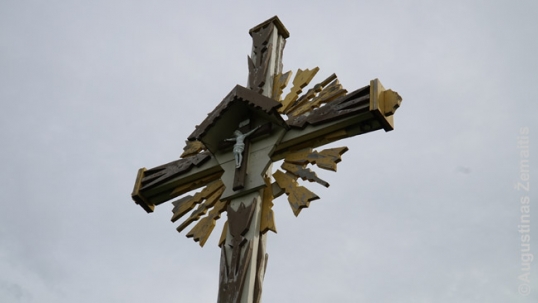
Close-up of one of the Dainava crosses
Another greatly atmospheric location is the Dainava open-air forest chapel where masses are held during the camping season. It is arranged so that behind its altar the Dainava Hill of Crosses would be visible in the distance. It is accessed by a narrow forest path. The path is surrounded by the Lithuanian stations of the cross. The forest chapel was created by priest Lukas Laniauskas. Next to the forest path entrance stands a Memorial to the founders of Dainava.

The altar and the view of the Hill of Crosses behind the altar in Dainava

Lithuanian station of the cross at Dainava forest calvary
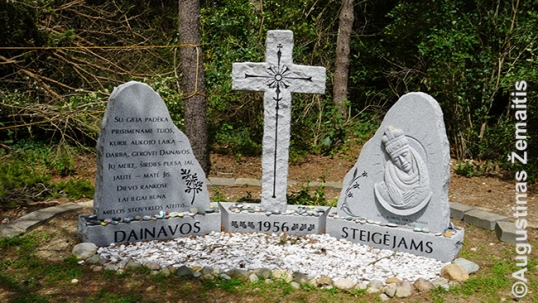
Memorial to the founders of Dainava
Dainava has so many religious symbols because it has been established by the American Lithuanian Roman Catholic Federation, of which a major part is Ateitininkai, a Lithuanian religious youth organization that has been banned under the Soviet occupation of Lithuania (1940-1990), yet it continued abroad in the USA. Catholic traditions are, therefore, an important part of the camps here. However, the Catholic art that is available in Dainava is also ethnic Lithuanian art, as traditional Lithuanian woodcarving style is always used to create it. One of the largest sculptures here is the Rūpintojėlis of Dainava - Rūpintojėlis being a traditional Lithuanian way to depict Jesus as a worried person. Catholic faith and Lithuanian culture are thus two pillars on which Dainava has been built.
The main building of the camp known as Adolfas Damušis house (also as "White House", built 1964) is surrounded by both religious and patriotic memorials, among them a wooden sculpture of St. Casimir (Lithuania's patron saint and the only Lithuanian saint), a memorial for Romas Kalanta (a Lithuanian who self-immolated against the Soviet regime in 1972) by Stasė Smalinskienė, a mural "Dainava - Our Lithuania" with the map of Lithuania, a ~2,5 m tall Rūpintojėlis engraved with stylized Lithuanian coat of arms (author Adolfas Teresius, 1999).
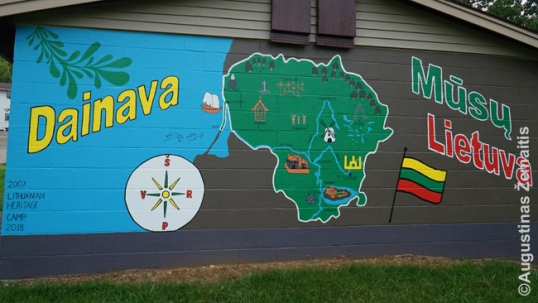
Mural "Mūsų Lietuva" (Our Lithuania)
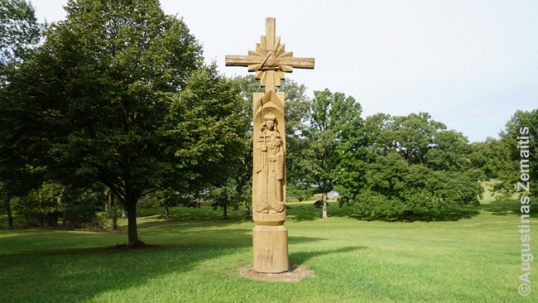
St. Casimir cross in Dainava

Romas Kalanta monument in Dainava
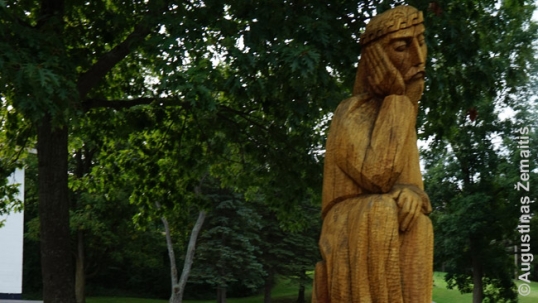
Dainava Rūpintojėlis (top)
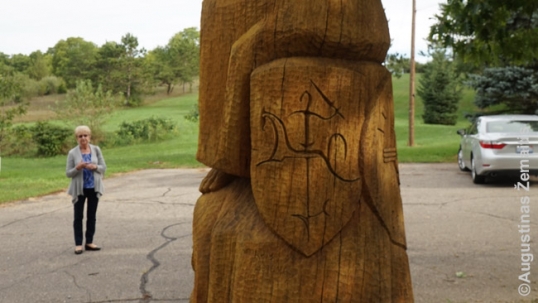
Lithuanian symbols on the back of Rūpintojėlis
There is also a milepost showing the distances from Dainava to various major world cities (and the cities the Dainava users come from) - it shows Lietuva as ~7400 km away. Like in Lithuania, the distances are marked in kilometers rather than miles.

Dainava milepost
On the far west of the camp, there is a beach on Thorn lake (often referred to in Lithuanian as "Spyglys"). This was the only place in the camp where a beach could be made and even creating such a small beach required a considerable engineering effort by the Lithuanians in the 1950s (engineer Adolfas Damušis, Baltakis, Bajorūnas). From the beach area, one may climb a hill, symbolically called Rambynas after an important hill in Lithuania's Nemunas Valley. That is the highest place in the camp and thus a popular hike among the Dainava campers, however, it lacks monuments and the views are obscured by trees outside of the winter when they open up more.
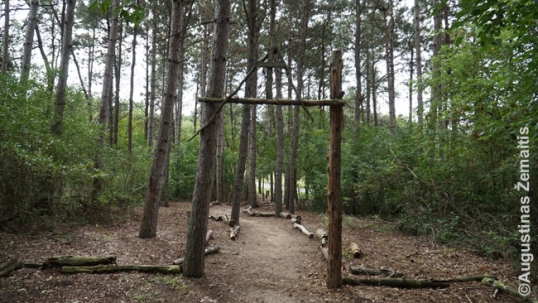
On top of the Rambynas hill
At the road fork where one road leads to the main building and another one to the beach and Rambynas, there is the Main Dainava sign carved in wood with Columns of Gediminas and Cross of Vytis on its top.
Dainava grounds were acquired by Lithuanians in 1955 and the camp was constructed in 1956, and constantly expanded since. The goals of Dainava were to create a summer space for Lithuanian kids where they could speak in Lithuanian to other Lithuanian kids and celebrate the Lithuanian culture. These were held to be especially important in the 1950s by tens of thousands of refugees from Lithuania who have arrived in the USA; most of these refugees saw themselves as exiled people as they would have been killed back in Lithuania which has been just occupied by the Soviet Union and they sought to perpetuate the Lithuanian culture in the USA. These days, "heritage camps" are also popular; in these camps, the main language used in English, however, the Lithuanian traditions are still the focal point of the activities. In addition to children camps, there are also camps for Lithuanian families and teachers of Lithuanian schools.
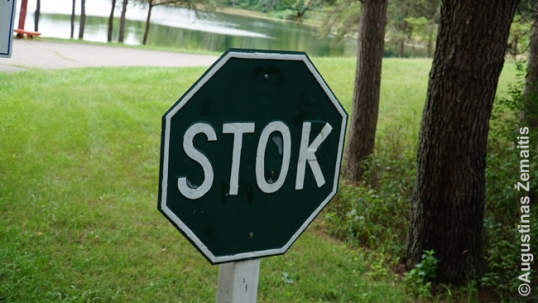
A STOP sign translated into Lithuanian as STOK and repaited in green, the traditional color of Lithuania
The initial site for Dainava was meant to be at the mid-point between the massive Lithuanian "colonies" of Chicago, Cleveland, and Detroit; however, in such a case, the camp would have been difficult to maintain as it would be too far from every "colony" for any Lithuanian to quickly go there. As such, it was decided to acquire a donated-to-university lot not too far from Detroit instead, so Detroit Lithuanians could care for it.

Dainava camp sign at the road
Dainava is accessible for the public outside of the hunting season. The camping season itself is summer-only and in the other times of the year, one pretty much could have Dainava for himself/herself (however, the camp is guarded and it is permitted only to hike or sightsee there but not to party).
Dainava has several buildings where the camping people sleep during the camping time (mostly summer). These buildings are locked out-of-season.
Pilėnai camp of Šauliai (Lithuanian National guard)
Pilėnai camp is literally on the opposite side of the road from Dainava. It hosts arguably the most important Lithuanian patriotic memorial in Manchester, the Memorial for those who died for Lithuania. The memorial consists of a pyramid with a soldiers face and a Cross of Vytis on his helmet. The sides include Cross of Vytis, Columns of Gediminas. On the lower side of the right side, famous Lithuanian freedom fighters and activists are listed, while on the left are the famous battles of Lithuanian wars of independence. The pyramid is crowned by a traditional Lithuanian sun-cross and surrounded by two traditional Lithuanian chapel-posts (koplytstulpiai), as well as flagpoles where the Lithuanian and American flags are raised every day when the camp is in use. The author of the monument is Mykolas Abarius.
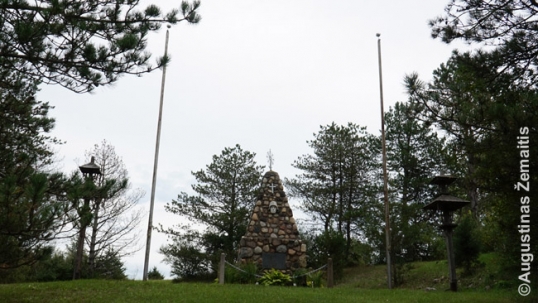
Monument for those who died for Lithuanian freedom at Pilėnai
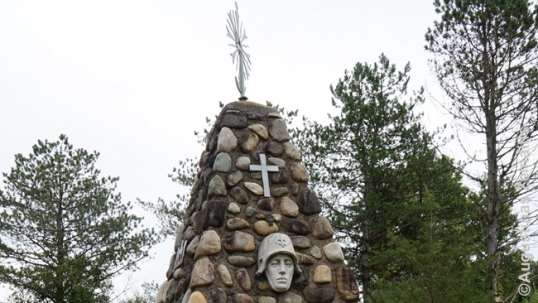
Close-up of the memorial for those who died for Lithuanian freedom
The camp gate is crowned by Iron Wolf sculptures (a traditional symbol of Vilnius city) and the columns of Gediminas. The total area of Pilėnai Camp is 20 acres (8 ha) and it includes a small lake. It has been expanded in the 2010s by acquiring additional land.
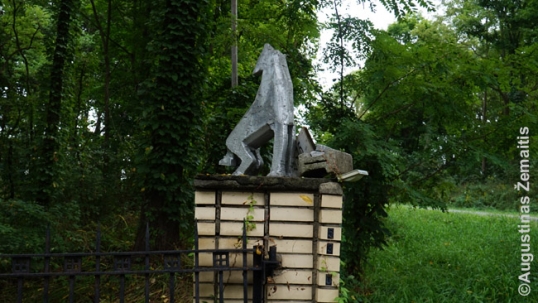
Iron Wolf at Camp Pilėnai opening gate

Camp Pilėnai entrance gate with Columns of Gediminas symbols
Pilėnai camp has been established ~1971 and is owned by the Šauliai movement, traditionally translated to English as "Lithuanian National Guard in exile" (also translated as "Lithuanian Riflemen"). Back in the years of the first independence of Lithuania (1918-1940), Šauliai were a potent paramilitary movement of patriotic volunteers who sought to learn better how to defend their homeland without joining the army. With tens of thousands of members, it was also a fraternal organization of such patriots. However, when the Soviets have occupied Lithuania in 1940, they added all the Šauliai members to the long list of people to be murdered or exiled. Some eventually managed to flee Lithuania and while Šauliai movement was destroyed in Lithuania itself, it continued "in exile" (being very patriotic, Šauliai generally saw their relocation to the USA as an exile rather than emigration, as they would have never emigrated if not the quick occupation without a real war and the subsequent Soviet Genocide).
The camp buildings hold various memorabilia for the Šauliai organization. Given the paramilitary nature of the organization, the camp also has a shooting range.
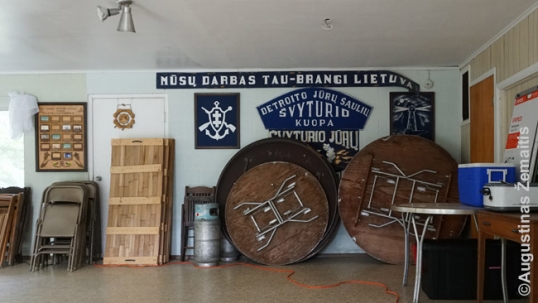
Interior of the camp Pilėnai main building
While Šauliai were on a long decline in America and their post-1990 recreation in Lithuania itself failed to reach the numbers the organization enjoyed between the wars, the Russian aggression in Ukraine has made the organization somewhat more popular in numbers as the perceived threat to Lithuania intensified greatly. Šauliai of Detroit that own Pilėnai increased threefold in numbers.
In addition to the Šauliai activities, Pilėnai also hosts the annual traditional Lithuanian Joninės (summer solstice) festival since 2010, attended by hundreds of Lithuanians (not just by Šauliai) who bring their own tents here. This is the best time to visit the camp and the Lithuanian memorial for non-members, as otherwise the camp is usually locked.
The map
All the Lithuanian locations, described in this article, are marked on this interactive map, made by the "Destination Lithuanian America" expedition (click the link):




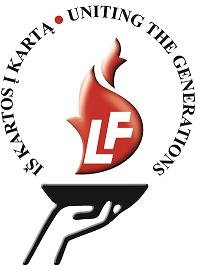

December 9th, 2018 - 21:02
Please note that “Smalinskiene” should say Stase Smalinskiene. She is my mother and was an accomplished artist, part of the group artists that emigrated during WWII.
December 9th, 2018 - 21:16
Thanks. I have edited the text now to include her name.